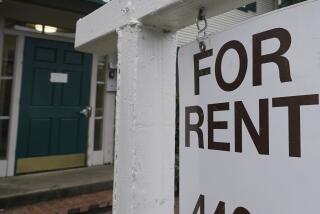Black Renters Met Bias, S.D. Study Finds
- Share via
SAN DIEGO — Blacks seeking to rent apartments in seven separate sections of San Diego faced some form of discrimination 40% of the time, according to a covert test of the housing market presented to the San Diego Housing Commission on Thursday.
In 14 of 35 locations, black test-renters seeking apartments were treated differently from white test-renters who applied for the same apartments on the same day, according to the report by the Urban League of San Diego, which conducted the test for the Housing Commission.
Although housing officials stressed that the test sample was too small to generalize the results for the entire city, “the survey served its purpose of giving a very good indication that there is discrimination out there,” said Evan Becker, the Housing Commission’s executive director.
Wider Testing Needed
Councilman Wes Pratt, the Housing Commission’s new chairman, called for wider testing of the rental market.
The study was part of a larger report by the city’s Fair Housing Task Force, which also concluded that the city has racially and ethnically segregated housing patterns, an imbalance that is partly attributable to low-income housing programs enacted by the city.
Poor whites are more broadly scattered about the city than poor minority groups, and blacks suffer more segregation than Hispanics, who are more segregated than Asians, the report stated.
Landlords and rental agents discriminated most frequently by misrepresenting the availability of apartments, the report shows. “White testers were given immediate dates and shown several apartments, as opposed to the black testers, who were given two weeks to one month for a unit to become available and a lesser number of apartments for consideration,” the report showed.
At one apartment complex, a white renter was given information on 10 apartments and told that one was available immediately. A black renter at the same apartment house was given information on only one apartment and told that none was available immediately. In all, the study documented 11 cases of misrepresented apartment availability.
The report also documented five examples of differing levels of courtesy to white and black renters, ranging from “very subtle to being outright rude.”
Two of the discrimination counts pertained to more extensive questioning of black renters’ marital status, and one consisted of a black renter receiving a much more detailed description of the difficulty of a required credit check.
“Differential treatment is differential treatment,” said Joan Dahlin, senior program analyst on the project for the Housing Commission, who said that such subtle discrimination has a “chilling effect” on blacks’ search for rental housing.
The survey did not reveal the names of the apartment projects, Dahlin said, because its purpose was to gather information rather than to enforce anti-discrimination laws. Under amendments to federal fair-housing laws, which take effect in March, real violations of statutes could bring fines of as much as $50,000.
Statistics on fair-housing violations in San Diego kept by the state Department of Fair Employment and Housing and the U. S. Department of Housing and Urban Development were unavailable Thursday.
All the violators in the study will be sent follow-up letters and invited to participate in fair-housing training sessions, said Elizabeth Morris, assistant executive director of the Housing Commission.
Some violations may have been inadvertent, said D. J. Ryan, executive director of the San Diego Apartment Assn. and a member of the Fair Housing Task Force.
“I think, with a lot of the discrimination, they don’t realize that what they just did was discriminating,” Ryan said. “They have to be informed that, when you do this and when you do this, it is discrimination.”
Projects Throughout City
All the apartment projects surveyed contained more than 20 units. They were in the Elliott, Linda Vista, La Jolla, University City, Mira Mesa, Mission Valley, Mission Bay, Pacific Beach, Rancho Bernardo, Rancho Penasquitos and Loma Portal neighborhoods.
The 22-member Fair Housing Task Force was formed by the Housing Commission in response to a 1986 letter from HUD requiring a more active fair-housing program in the city of San Diego.
The group found that the number of city census tracts where blacks are more than 50% of the population declined from nine in 1970 to seven in 1980. But this was because of the addition of members of other minorities rather than integration with whites. The white population of those census tracts dropped during that decade.
The task force also noted that San Diego has no nonprofit or governmental fair-housing organization to assist state and federal enforcement. Los Angeles has seven such groups.
The group called for the use of land banking--a practice under which land is purchased and set aside for use as the site of low-income housing--to help develop public housing for the poor.
It also said the city’s commitment to its “balanced community policy,” under which public housing for the poor is scattered around the city, needs strengthening as the cost of land and housing continues to skyrocket.
More to Read
Sign up for Essential California
The most important California stories and recommendations in your inbox every morning.
You may occasionally receive promotional content from the Los Angeles Times.













